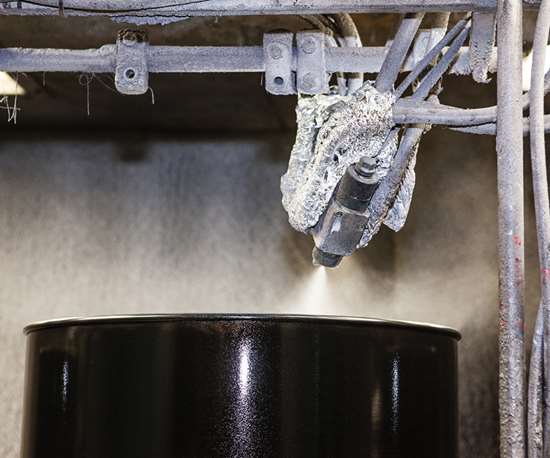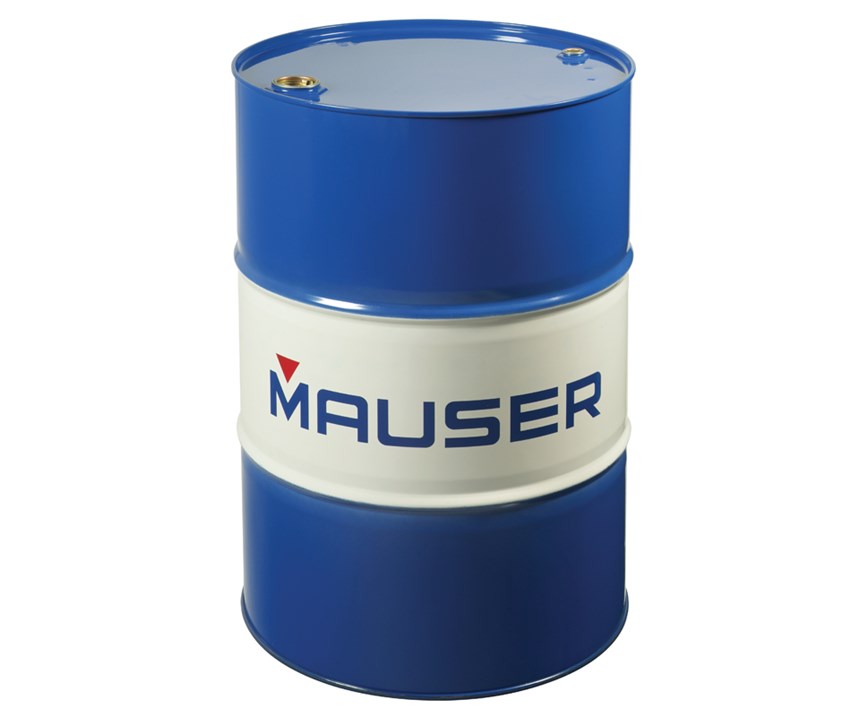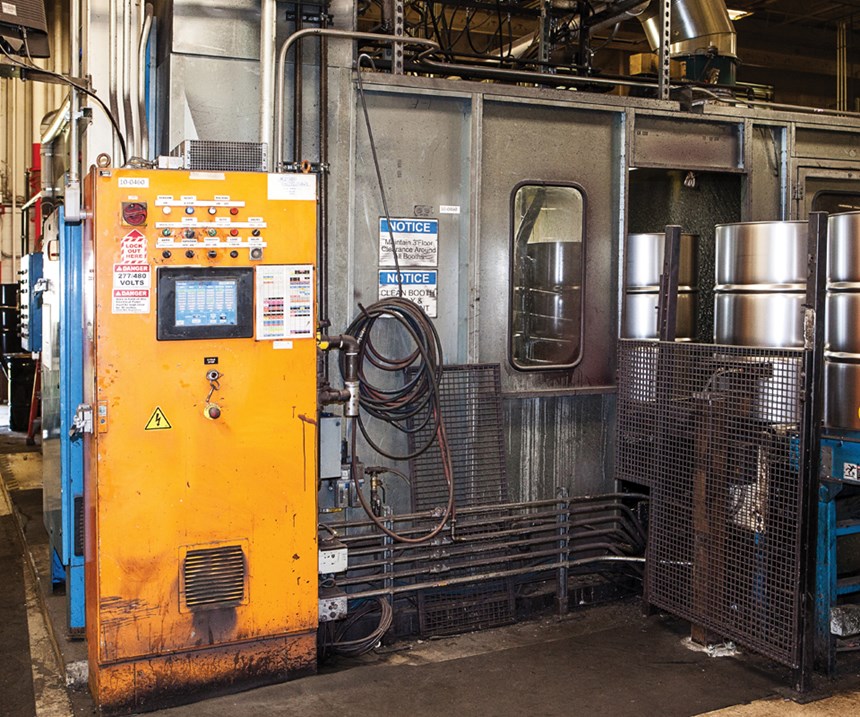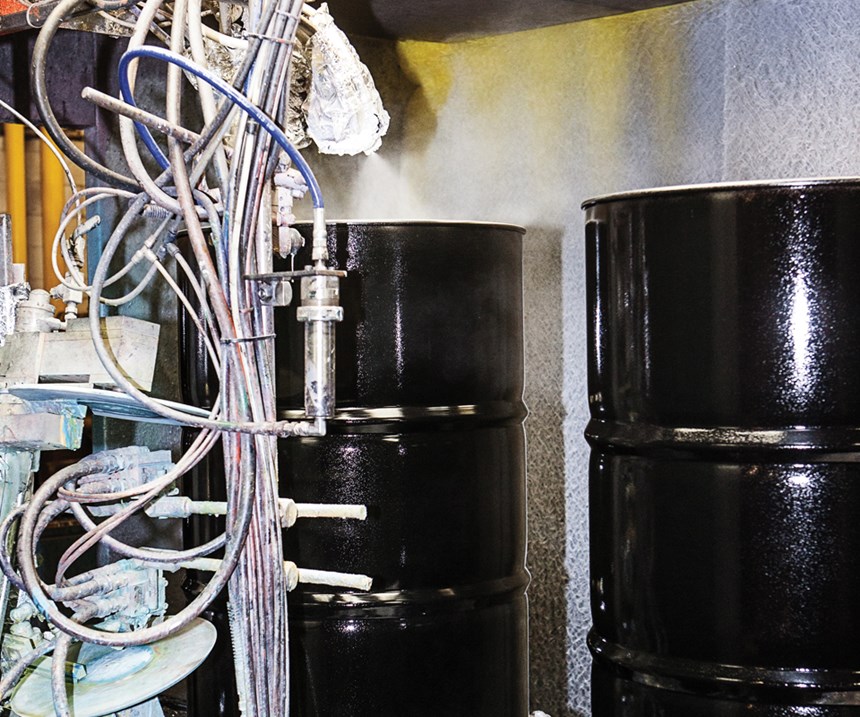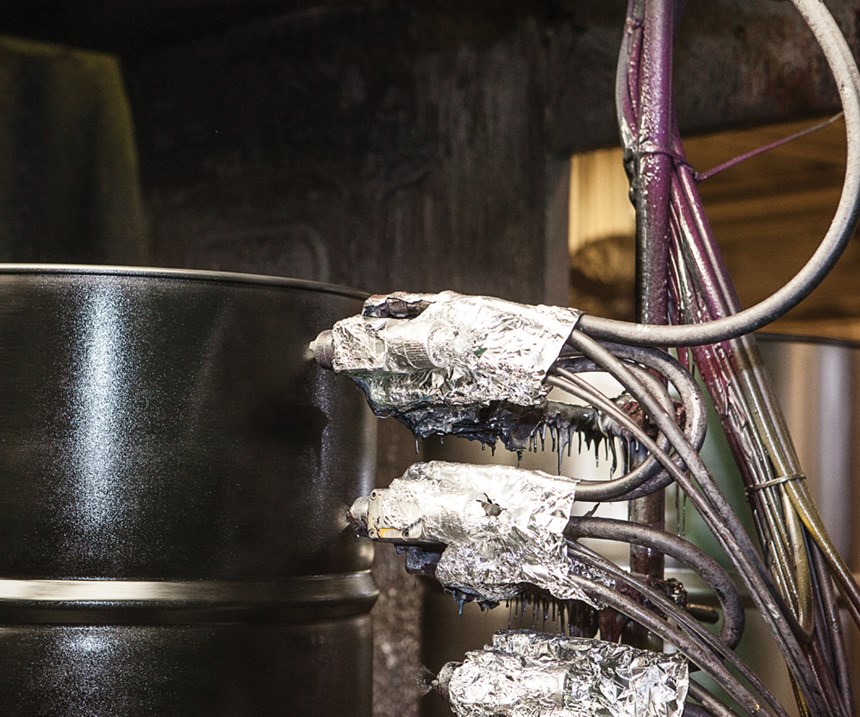Getting the Most from a Liquid Paint Line Audit
Appears in Print as: 'In-Tune Liquid Equipment Makes for a Barrel of Fun'
An audit of its liquid coating system led to more than $100,000 in savings for this Pennsylvania maker of steel storage drums.
In manufacturing, it is called drift: the operational phenomena whereby practices and procedures move away over time from optimized performance. Where turning the knob to 5 seems to produce just as good a job as when it was set to 3.
Almost all parts of the manufacturing process are victimized by it, especially finishing, where the amount of liquid paint that is sprayed on a part gets edged up over the months and years after the finishing equipment was first installed and dialed in.
Featured Content
“It happens to the best of us,” says Jim DiFonzo, plant manager at Mauser, a Warren, Pennsylvania, shop that makes steel drums for the holding and handling of dangerous products, especially for the chemical and petrochemical fields.
DiFonzo couldn’t detect from the naked eye what was happening with his plant’s paint line, but he knew that it was time for some adjustments five years after SAMES KREMLIN of Plymouth, Michigan, installed the coating equipment Mauser uses to paint the millions of barrels it produces each year.
“Nothing was obvious, but the applicators and I knew that maybe we needed to refresh how we were doing things and have a reset,” DiFonzo says.
Help from the Manufacturer
It was the same thought process Sames Kremlin’ Steve Romer, a senior systems application engineer, was going through. About a year ago, he came up with the idea of conducting “performance audits” on systems that Sames Kremlin had installed in plants within the previous few years, with hopes of fine-tuning operations and improving performance.
“I have seen over the years where there has been a natural drift from the original settings and procedures that were put in place when equipment is installed,” he says. “Equipment gets a little bit old, and an operator might start making changes. But often those changes lead to a decrease in transfer efficiencies that no one wants to happen.”
Sames Kremlin had installed a bevy of high-tech equipment at the Mauser plant, including 12 AVX Automatic Airmix spray guns, six Flowmax pumps, 12 Ad-60 paint heaters, five CTM color changers, five Gold Top fluid pressure regulators, a secondary heat transfer system and a system controller.
All this equipment is very high-tech and efficient, but only if the proper settings are followed and practiced, Romer says.
“It is really good equipment, and we always make sure that we fine-tune it specifically to the application of the customer, which it was five years ago,” he says. “But things had changed, as they always do.”
Corrosion-Resistant Process
Founded in 1896 and headquartered in Bruhl, Germany, near Cologne, Mauser has a worldwide market presence, boasting more than 60 locations in more than 30 countries and serving international companies in the chemical, petrochemical, pharmaceutical and food industries.
Mauser was applying more than 60 different colors of a PPG liquid coating to its steel barrels and lids. The company had pioneered the triple-seam and W-shaped rolling hoop design for strength and durability of its barrels, and had gained huge amounts of market share because of its innovative designs. In fact, Mauser touts its steel drums not only as a robust and reliable rigid packaging solution, but also as one that can be visually customized with decorative painting, making the drums a preferred choice in multiple industries, the company says.
The barrels are made from standard cold-rolled steel for protection against corrosion. Because they are usually in long-term storage outdoors in harsh weather conditions, stored close to the seaside or filled with goods that require the highest level of cleanliness, DiFonzo says corrosion protection combined with excellent paint adhesion is key.
“The equipment that Sames Kremlin put in was top-notch for us,” he says. “It really did the job in what we needed.”
Mauser had developed a new process for the barrels it dubs MSDP, Mauser Steel Drum Protected, highlighting the innovative surface treatments it uses on the base steel, which it says provide better paint adhesion and protection against corrosion than drums produced from electro-galvanized steel.
Process Audit
Romer approached DiFonzo about conducting a performance audit on the Sames Kremlin equipment in the Mauser plant, and the plant manager immediately took the idea to his superiors to get buy-in. There would be costs involved, but Romer said it would be insignificant compared to what the possible savings could be.
“There is an expense, but it all goes back to the value of it all,” he says. “What it comes down to is working towards a significant cost savings and overall improved performance.”
Romer paid a visit to the Mauser plant and initially spent time observing how the operators were coating the drums and lids. After seeing some inconsistencies with how the original equipment was set up to operate, he conducted a full system audit to help improve paint efficiencies, provide operator training and develop operational procedures.
Over the course of three days, Romer was hands-on with the Mauser operators, working with them on dialing in the Sames Kremlin equipment and practicing proper techniques to get the best transfer efficiency and reduce rejects.
“Once a drift happens in how things were originally set up and supposed to work, it then becomes second nature to the paint operators in how they work day in and day out,” Romer says. “Pretty soon the entire system is out of line and you get some serious inefficiencies in your overall operation.”
Plus, all the bugs of a system are not always removed when they are initially installed, he says, because it takes time to see how transfer efficiencies are developing and what minor adjustments are needed in the first several weeks and months of use. Those adjustments often don’t happen.
“It is so much better to come back six months or one year after a system is started and really optimize how it is run,” he says. “For Mauser, we had a five-year track record to work with.”
Romer’s first step was to measure how much paint the shop was using, weighing the paint filters at the end of each production shift and charting how steadily the weight dropped as the system began getting optimized.
Romer says the filters were weighing in at 30 pounds when he started the audit, but by the end, they weighed less than 20 pounds, signifying a significant drop in waste and an improvement in efficiency.
“It was probably even more of a savings because, while that may be 10 pounds of paint, most of the solvent and water was gone from the filters, so it was a lot more,” he says. “It’s hard to see exactly where savings are taking place.”
Sames Kremlin had seen this before, Romer says, citing as another example a California door maker that was running its doors through the paint line three times to get proper coverage. After an audit, that plant changed the set points of its guns and was able to get the required coverage in just one pass through the system.
Changing Habits
DiFonzo said the paint operators at Mauser were aware that changes had been made to the equipment setup over the years and were very welcoming of an audit that would help improve coating performance.
“My team was great in how they approached this,” he says. “They want to get things right the first time, and they didn’t feel challenged by Steve coming in here. He spent a lot of time with them in the paint booth and on the line to fine-tune everything. It was a great opportunity to work with another set of eyes, and my people accepted that challenge.”
Romer said the key to finding discrepancies and eventually changing operators’ habits is to invest time with each of them to see how they perform their jobs.
“You can walk in and make four or five recommendations and then walk out, and nothing will change,” he says. “It takes time to understand all the nuances of the line and the operators, and get it in sync with the equipment. That is the goal.”
The audit revealed that Mauser’s spray times and pressures weren’t being run properly, and the viscosity of the paint being applied was off as well. As it turned out, the gun settings were also wrong.
“What I have seen over time is that most of the original parameters set in place float away over the first 12 months,” Romer says. “And honestly, the people operating the system just don’t know it is happening.”
When the Mauser audit was finished, it was like night and day operationally, DiFonzo says. Among the results were:
- Yearly savings on paint through improved transfer efficiency.
- Improved paint quality on the drum heads.
- Improved paint quality on the drum sidewalls, specifically on multi-colored drums.
- A well-defined process with specific work parameters that simplifies setup for the operator and enables consistency when the primary operator is out.
- Fewer line stops due to equipment issues, thanks to improved preventive maintenance by operators on spray nozzles and on the system in general.
- Improved quality in general through better practices in handling/managing the raw material inventory, including paint.
$104k in Savings Through Increased Efficiency
Overall, Mauser saw an 18 percent reduction in the amount of liquid paint it used, leading to a monumental savings financially.
“We saved just over $104,000 in paint costs alone,” DiFonzo says. “It got everyone’s attention around here. I’m a process engineer, and I can get really excited about 5 and 10 percent improvements. What Steve did for us was absolutely fantastic.”
The company achieved this savings by identifying and improving on different parts of its processes. For example, the team homed in on a specific application for coating the lid of a 55-gallon drums, a 22.5-inch disc that required use of four paint nozzles at Station 2.
After carefully examining the existing setup, the operators determined that the four spray guns were affecting each other’s streams, causing overspray. They tried several different setups and altered the number of guns, eventually separating the four guns and placing two at Station 2 and two at Station 3. The reduction in overspray and drips was remarkable, DiFonzo says.
“It’s all trial and error,” he says. “Part of it is using best practices, and part of it is having a guy like Steve who has been in a lot of plants and knows what works best.”
Several months removed from the audit, DiFonzo says there is little to no drift from the protocols that were set up after the audit, and he and his team are watching more closely for changes from original settings.
He says the shop and its operators weathered the audit well, and have come to appreciate the experience as a way to better themselves and the processes.
“It was a commitment from us dollar-wise, but the result was truly more than we ever imagined,” DiFonzo says.
For information on Mauser, visit mausergroup.com. For information on Sames Kremlin, visit sames-kremlin.com/usa/en.
RELATED CONTENT
-
Coating Thickness Measurement: The Fundamentals
A review of available test methods, common applications and innovative instrumentation...
-
Is Your Electroplating Waste Hazardous?
Some that bears precious metals is, and there are a host of regulations to consider when recycling.
-
Curing Oven Basics
Simply heating up the substrate does not cure the coating. There are many variables to consider when choosing the best cure oven for your application...


